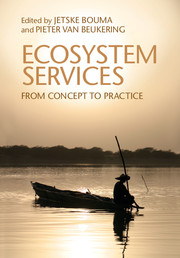Book contents
- Frontmatter
- Contents
- About the authors
- Part I Introduction
- Part II Measuring ecosystem services
- Part III Valuing ecosystem services
- Part IV Paying for ecosystem services
- Part V Governing ecosystem services
- 10 Global governance of ecosystem services and related policy instruments
- 11 Public–private partnerships and the governance of ecosystem services
- 12 Local governance of ecosystems and community co-management
- Index
- Plate section
- References
10 - Global governance of ecosystem services and related policy instruments
from Part V - Governing ecosystem services
Published online by Cambridge University Press: 05 February 2015
- Frontmatter
- Contents
- About the authors
- Part I Introduction
- Part II Measuring ecosystem services
- Part III Valuing ecosystem services
- Part IV Paying for ecosystem services
- Part V Governing ecosystem services
- 10 Global governance of ecosystem services and related policy instruments
- 11 Public–private partnerships and the governance of ecosystem services
- 12 Local governance of ecosystems and community co-management
- Index
- Plate section
- References
Summary
Introduction
Humans live off the bounty of the earth. In order to be able to sustainably enjoy these resources, humans need to organize their relationship with the earth. This organization is in terms of governing the use and abuse of the earth’s resources. The Global Environmental Outlook (UNEP, 2012) published by the United Nations Environment Programme (UNEP) argues that growing economies and populations within the context of complex globalization are leading to unprecedented pressures on the environment and ecosystem services. This calls for strong and effective governance!
There is nothing new about environmental governance and the study of environmental governance. For example, the history of water governance can be traced back some thousands of years (Dellapenna and Gupta, 2009). However, it would be fair to say that environmental governance came into its own in the twentieth century and that the study of environmental law, politics, policy, and economics has been on the agenda for at least the last 60 years. Numerous books and articles discuss environmental governance from the local to the global level. Such books include Carson’s (1962) Silent Spring, Falk’s (1971) This Endangered Planet, Ward and Dubos’ (1972) Only One Earth, Meadowset al.’s (1972) The Limits to Growth, and many others. These have paved the way to shaping global concerns on the environment.
- Type
- Chapter
- Information
- Ecosystem ServicesFrom Concept to Practice, pp. 201 - 229Publisher: Cambridge University PressPrint publication year: 2015
References
- 3
- Cited by



